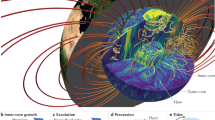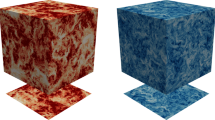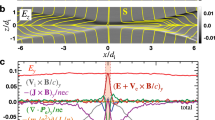Abstract
In the Earth's fluid outer core, a dynamo process converts thermal and gravitational energy into magnetic energy. The power needed to sustain the geomagnetic field is set by the ohmic losses (dissipation due to electrical resistance)1. Recent estimates of ohmic losses cover a wide range, from 0.1 to 3.5 TW, or roughly 0.3–10% of the Earth's surface heat flow1,2,3,4. The energy requirement of the dynamo puts constraints on the thermal budget and evolution of the core through Earth's history1,2,3,4,5. Here we use a set of numerical dynamo models to derive scaling relations between the core's characteristic dissipation time and the core's magnetic and hydrodynamic Reynolds numbers—dimensionless numbers that measure the ratio of advective transport to magnetic and viscous diffusion, respectively. The ohmic dissipation of the Karlsruhe dynamo experiment6 supports a simple dependence on the magnetic Reynolds number alone, indicating that flow turbulence in the experiment and in the Earth's core has little influence on its characteristic dissipation time. We use these results to predict moderate ohmic dissipation in the range of 0.2–0.5 TW, which removes the need for strong radioactive heating in the core7 and allows the age of the solid inner core to exceed 2.5 billion years.
This is a preview of subscription content, access via your institution
Access options
Subscribe to this journal
Receive 51 print issues and online access
$199.00 per year
only $3.90 per issue
Buy this article
- Purchase on Springer Link
- Instant access to full article PDF
Prices may be subject to local taxes which are calculated during checkout



Similar content being viewed by others
References
Buffett, B. A. Estimates of heat flow in the deep mantle based on the power requirements of the geodynamo. Geophys. Res. Lett. 29, doi:1.1029/2001GL014649 (2002)
Roberts, P. H., Jones, C. A. & Calderwood, A. R. in Earth's Core and Lower Mantle (eds Jones, C. A., Soward, A. M. & Zhang, K.) 100–129 (Taylor & Francis, London, 2003)
Labrosse, S. Thermal and magnetic evolution of the Earth's core. Phys. Earth Planet. Inter. 140, 127–143 (2003)
Gubbins, D., Alfè, D., Masters, G., Price, D. & Gillan, M. J. Can the Earth's dynamo run on heat alone? Geophys. J. Int. 155, 609–622 (2003)
Nimmo, F., Price, G. D., Brodholt, J. & Gubbins, D. The influence of potassium on core and geodynamo evolution. Geophys. J. Int. 156, 363–376 (2004)
Stieglitz, R. & Müller, U. Experimental demonstration of the homogeneous two-scale dynamo. Phys. Fluids 13, 561–564 (2001)
Gessmann, C. K. & Wood, B. J. Potassium in the Earth's core? Earth Planet. Sci. Lett. 200, 63–78 (2002)
Langel, R. A. & Estes, R. H. A geomagnetic field spectrum. Geophys. Res. Lett. 9, 250–253 (1982)
Kuang, W. & Bloxham, J. An Earth-like numerical dynamo model. Nature 389, 371–374 (1997)
Roberts, P. H. & Glatzmaier, G. A. A test of the frozen-flux approximation using a new geodynamo model. Phil. Trans. R. Soc. Lond. A 358, 1109–1121 (2000)
Christensen, U., Olson, P. & Glatzmaier, G. A. Numerical modeling of the geodynamo: a systematic parameter study. Geophys. J. Int. 138, 393–409 (1999)
Kutzner, C. & Christensen, U. R. From stable dipolar to reversing numerical dynamos. Phys. Earth Planet. Inter. 131, 29–45 (2002)
Müller, U. & Stieglitz, R. The Karlsruhe dynamo experiment. Nonlin. Proc. Geophys. 9, 165–170 (2002)
Tilgner, A. Numerical simulation of the onset of dynamo action in an experimental two-scale dynamo. Phys. Fluids 14, 4092–4094 (2002)
Hulot, G. & LeMouël, J. L. A statistical approach to the Earth's main magnetic field. Phys. Earth Planet. Inter. 82, 167–183 (1994)
Bloxham, J. & Jackson, A. Time-dependent mapping of the magnetic field at the core-mantle boundary. J. Geophys. Res. 97, 19537–19563 (1992)
Buffett, B. A. The thermal state of the Earth's core. Science 299, 1675–1676 (2003)
Rama Murthy, V., van Westrenen, W. & Fei, Y. Experimental evidence that potassium is a substantial radioactive heat source in planetary cores. Nature 423, 163–165 (2003)
McElhinny, M. W. & Senanayake, W. E. Paleomagnetic evidence for the existence of the geomagnetic field 3.5 Ga ago. J. Geophys. Res. 85, 3523–3528 (1980)
Secco, R. A. & Schloessin, H. H. The electrical resistivity of solid and liquid Fe at pressures up to 7 GPa. J. Geophys. Res. 94, 5887–5894 (1989)
Bloxham, J., Gubbins, D. & Jackson, A. Geomagnetic secular variations. Phil. Trans. R. Soc. Lond. A 329, 415–502 (1989)
Acknowledgements
We thank U. Müller for the permission to use unpublished results from the laboratory dynamo experiment. This work was supported by the priority programme “Geomagnetic secular variations” of the Deutsche Forschungsgemeinschaft.
Author information
Authors and Affiliations
Corresponding author
Ethics declarations
Competing interests
The authors declare that they have no competing financial interests.
Rights and permissions
About this article
Cite this article
Christensen, U., Tilgner, A. Power requirement of the geodynamo from ohmic losses in numerical and laboratory dynamos. Nature 429, 169–171 (2004). https://doi.org/10.1038/nature02508
Received:
Accepted:
Issue Date:
DOI: https://doi.org/10.1038/nature02508
This article is cited by
-
Sustaining Earth’s magnetic dynamo
Nature Reviews Earth & Environment (2022)
-
Geodesy, Geophysics and Fundamental Physics Investigations of the BepiColombo Mission
Space Science Reviews (2021)
-
The BepiColombo Planetary Magnetometer MPO-MAG: What Can We Learn from the Hermean Magnetic Field?
Space Science Reviews (2021)
-
A candidate secular variation model for IGRF-13 based on MHD dynamo simulation and 4DEnVar data assimilation
Earth, Planets and Space (2020)
-
Response of phytoplankton to banana cultivation: A case study of Lancang-Mekong River, southwestern China
Scientific Reports (2019)
Comments
By submitting a comment you agree to abide by our Terms and Community Guidelines. If you find something abusive or that does not comply with our terms or guidelines please flag it as inappropriate.



